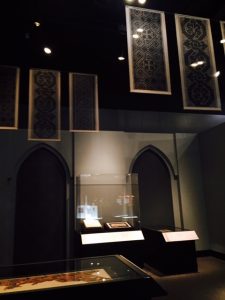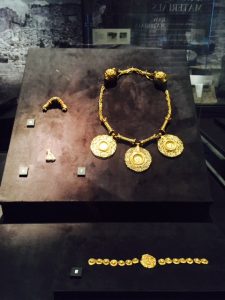Visitors stepping into “Ancient Mediterranean Cultures in Contact” at the Field Museum are likely to have a preconceived notion that they will be looking at exceptional examples of jewelry, pottery and probably a mummy and objects from Pompeii. But you would be just partially right.

Those items are there. In fact, there are about 100 fine examples of early Egyptian, Etruscan Greek and Roman objects pertaining to their polytheistic societies. But there is also a clip from a CNN broadcast at the entrance and Coptic material from a later monotheistic culture plus a modern day child’s life jacket at the end.
Curving around through the exhibit guests pass tall story boards about societal changes regarding religions, language and ideas. One board says: As Ideas Move Societies Change.
The boards are reminders that even back in the time the objects were made, whether BC or early A.D., the people using them were members of societies influenced by other cultures through trade, travel and wars and that they valued or argued about techniques and ideas from other places.
One board says: “When societies interact, things move, people move and ideas move.” It goes on to explain: “We experience this in our own lives when we buy imported fruit at the store, talk to a neighbor who grew up in another country or take a yoga class at the gym. But the movement of things, people and ideas across cultures isn’t new – this has been going on since the beginning of human history.”

Bill Parkinson who put the exhibition together originally considered doing an exhibit of Roman and Etruscan cultures. “The Field has fabulous Roman and Etruscan collections,” said Parkinson, associate curator of Eurasian anthropology.
But then he added that when an exhibit begins with the word “The” as in “The Greeks,” which, by the way, was a very fine Field exhibit November 2015 to April 2016, it concentrates just on one culture’s objects and contributions.
He pointed out that the idea for the current exhibit which opens Oct. 20, 2017 and continues through April 29, 2018, began about the same time as “The Greeks” but with a different objective
“It is about ideas. We’re telling stories about people. It’s interesting looking 800 to 200 B.C at the Etruscans, Rome, Pompei and how they relate to each other. As we pulled it all in, how Etruscans related to Greece and Rome related to Egypt it was an Oh, moment. The connections exploded,” Parkinson said.
The Coptic material is also important. “When cultures went from polytheistic to monotheistic those connections exploded. One god became critical during the first millennium. (January 1, AD 1, and ended on December 31, AD 1000), he said.
Tip: Because this exhibit is about connections rather than what happened first and second, it’s arranged by influences and connections, not chronologically. So while enjoying such objects as a necklace, a well-carved figure or an attractive pot, look at their descriptions because they mention influences such as how an item was made by one society in the style of a different culture.

“The objects tell stories. When we pulled them for the collection we did so to tell a truth about the time,” Parkinson said.
The exhibit also makes the point with TV broadcasts and found objects that societal connections continue today.
Or as Parkinson noted: “You don’t expect to see CNN or another headline when you walk into an ancient Mediterranean show or see Coptic material at the end.”
The Field Museum is at 1400 S. Lake Shore Drive, Chicago. “Ancient Mediterranean Cultures in Contact” goes from Oct. 20, 2017 through April 29, 2018. This is a ticketed show. For tickets, hours and other information call (312) 922-9410 and visit Field Museum.
